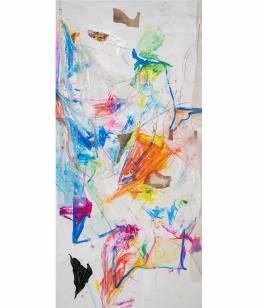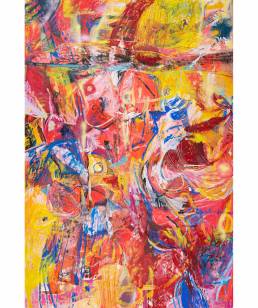Meeting the body as touching the memory in the print of colour
Poetry
Nina Stopar’s art is based on poetry. She has been writing erotic and love poetry for many years. Her words – spoken or written – are left adrift in the currents of time, waiting for readers. But only the written words can transcend the currents of transience, movement or dance and speak to the reader for longer or for ever. In Nina Stopar’s art, the poetry and painting define the constellation of three bodies – poetry, dance and painting. To find the Lagrange point of this three body constellation we must ignore the mass of one of them. Affected by the gravity of two bodies, the third, smaller body will sit virtually still at this point. It is possible that poetry and painting are these two bigger bodies of her creation while the emanation of dance is at a standstill. Abstract, undefined compositions, closer to natural disorder and imaginary landscapes focus their associative stream with the help of poetry. Colours that appear in the poems spill onto the canvas. However, it remains a mystery whether these colours contain hidden meanings separate from the traditional or psychological ones.
Calligraphy
Nina Stopar records her poems in a sketchbook, sometimes accompanied with a sketch that might be explicitly erotic or is an abstract composition. The motion that fluidly transforms from writing into lines as foundations of the artistic language is thus freed from pictographic meaning. Thus the artist successfully transitions from literature to drawing and thus transubstantiates dance into the point of virtual stillness that characterizes her first work of art. The drawings are the beginning, they carry the primal nature that is only present in drawings but can also be manifested in dance. Nina Stopar thus transcends the conflict between the image and language of literature, connecting them both with lines into a new congruent whole and constantly moves between dance as dance and dance as the point of virtual stillness in the constellation.
Dance
Nina Stopar starts the creative process as a dancer whose immateriality and ephemerality of movement are embodied in colours and lines. “I start by lying on an empty canvas. I breathe and feel and then I start moving, creating. I trust the body. The body knows lines, colours and shapes. The body can paint. I call the creative process the intuition of the body and my art intuitive art.”
Dance is the starting point for large scale paintings. The motions of hands, feet and other parts of the body immersed in paint leave traces on the white canvas. She calls this painting with the body body intuition. These days body movements are considered a part of performative arts. Dance or movement as a method of communication exists in other species and that gives it the impression of primacy and primitivity and consequently directness. Dance is a method of expression for all cultures from the start of Homo Sapiens.
Unlike other paintings through the centuries, Nina Stopar’s paintings cannot simply be seen as images or representations because her painting is not an rationally controlled process of applying paint, lines or other artistic elements on the canvas, but mostly a spontaneous, random process defined by the movement of the body on the surface. It certainly still is painting if we consider the result – the painting – but painting with body intuition arises from different sources. If art, not only painting, can also be therapy for the creator1, Nina Stopar movesthrough and beyond that as she follows what she cannot escape – body intuition. Her paintings are a materialization of dance, body movements, spontaneous and raw, as they are, purified of all cultural traces which manifest on the artistic level as clear, defined and known. After dance, her basic act of creation, finishes, Nina Stopar sometimes completes the painting with traditional painting algorithms, which allows the painting to became a work of art with all aesthetic and economic components. Her paintings are condensed wishes that remained after dance becomes apparently still. An embodied wish for words. A wish for dance that stood still.
1 Artist’s note: “This has nothing to do with victimhood, art has always been therapeutic for artists to a certain extent and there is nothing wrong with that, but it is true that in the last century it has been developed separately as a form of therapy. That is not what I mean here, I want to say that just like horse riding is relaxing, so art in a certain segment can be like that, but I speak only about the expressive note of art – the transformation of emotion, anger, broken heart, social disharmony into painting. Because I move from learned movements to the purified spontaneous intuitive movements, my paintings transcend abstrac expressionism. That also answers the below comment.”
Note: “Note – therapy: Greek theatre, especially tragedies with their catharsis were therapeutic for the audience. And on the other hand art always partly had such a function, for example the still existing romantic stereotype that good art arises from suffering or the line from Prešeren’s poem to the Poet ‘Remember your profession, suffer with no peace!’ Expressive art solely arose from the internal emotional worlds of individuals and transformations of those states which is also one of the characteristics of therapy.”
Jernej Kožar


















